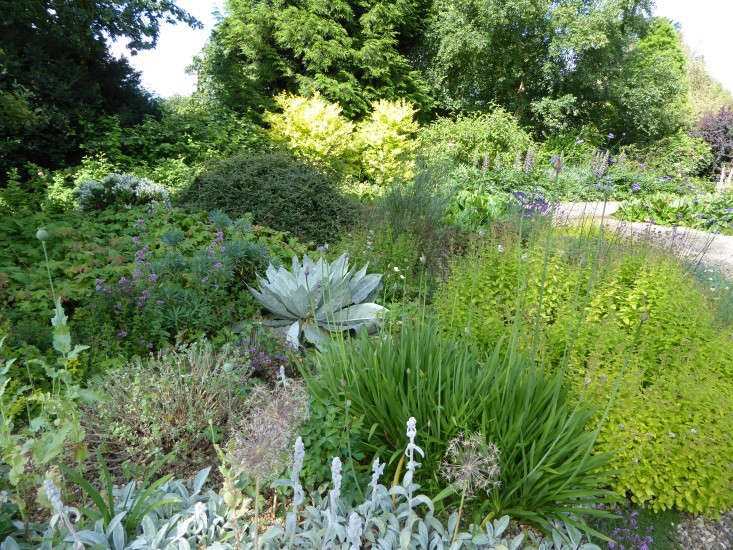Agave, Agave americana: “Century Plant”
Sometimes even in a very small garden you need something dramatic, a focal point that catches the eye. You might consider installing an ornament—an urn or a fountain or statue—but it would be simpler and a lot less expensive to use a plant instead. That’s where the Agave family comes in. It’s a genus of stunners: perennial succulents (sometimes quite large) with long, shapely leaves that grow in rosettes. With approximately 200 species, the agave’s color palette ranges from dusty gray, to kelly green, to bright yellow with green stripes, and even to blue.

Agaves are related to yuccas, dracaenas, ponytail palms, and Joshua trees but not, as many people assume, to cacti. Their elegant symmetrical shapes, their easy—almost effortless—maintenance, and their ability to thrive on very little water makes them prime candidates for the modern gardener interested in drought-tolerant beauty without back-breaking labor.

Agaves are native to Mexico, the Caribbean, northern South America, Central America, and the southwest United States. A commonly grown US native is Agave americana. It is also called “American aloe” (although it’s not an aloe) and “Century plant,” which refers to its tendency to be slow to bloom. “Century” is an exaggeration. Agave americana usually blooms in 10 to 25 years. Its yellow flowers are carried high above the plant on a giant asparagus-like stalk that can grow more than 15 feet high. It’s a dramatic but bittersweet display because the plant, like many in its genus, is monocarpic: It dies after blooming.

Cheat Sheet
- Plant your agave away from high-traffic areas such as walkways. The edges and pointed tips of agave leaves are very sharp and can cause injuries which are slow to heal because the leaves contain an anticoagulant.
- Agaves can grow as large as 20 feet in diameter, making them good background plants as well as appropriate companions for low-growing succulents, such as sedums.
- Agaves can be grown in pots and are great on patios, although you will have to bring them indoors in winter unless you live in a climate with very moderate weather.

Keep It Alive
- Agaves that are grown outside require dry desert climates with winter temperatures above 25 degrees Fahrenheit. Most varieties do best in growing zones 8 to 10.
- Good drainage is key to a healthy agave. If your soil is clay-based, add some sand or grit to make sure your plant does not have to sit in a swamp.
- Agaves need a lot of sunlight, but avoid planting them where they will have to endure blistering desert sun. A bit of shade in the hottest part of the day is well tolerated by these plants.
Gardeners who live in areas at risk from wildfires would do well to use agave and other succulents in their gardens. These plants store water in their leaves and stems, which actually makes them fire retardant. Not only will they most probably not go up in flames themselves but also they can protect the buildings they surround.

Above: Photograph by Clare Coulson for Gardenista. For more of UK garden designer Beth Chatto’s dry garden, see Expert Advice: 11 Tips for Gravel Garden Design.
Agave has a long history of providing benefits to humans. When the Spanish conquistadores arrived in Mexico, the indigenous people were already consuming a fermented agave beverage called pulque. Today agaves are grown for agave syrup (touted as a healthy sweetener) and fiber to make twine, clothes, and rugs. However, the agave’s most celebrated product is definitely the liquor used to make a very popular cocktail. The next time you order a margarita you just might want to toast the beautiful blue Agave tequiliana, from which all tequila is made, and the Mexican farmers who cultivate it in the state of Jalisco.
See more tips to successfully plant, grow, and care for agave at Agave: A Field Guide. If you’re planning to add succulents to a garden design, see our recent posts, Gardening 101: Aloe Vera and 10 Easy Pieces: Best Succulents.
Interested in other succulents or cacti? Get more ideas on how to plant, grow, and care for various succulents and cacti with our Succulents & Cacti: A Field Guide.









Have a Question or Comment About This Post?
Join the conversation